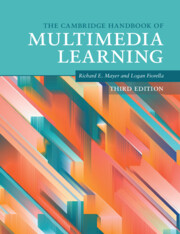Book contents
- The Cambridge Handbook of Multimedia Learning
- The Cambridge Handbook of Multimedia Learning
- Copyright page
- Contents
- Figures
- Tables
- Contributors
- Preface
- Acknowledgments
- Part I Background
- Part II Theoretical Foundations
- Part III Basic Principles of Multimedia Learning
- Part IV Principles for Reducing Extraneous Processing in Multimedia Learning
- Part V Principles for Managing Essential Processing in Multimedia Learning
- Part VI Principles Based on Social and Affective Features of Multimedia Learning
- Part VII Principles Based on Generative Activity in Multimedia Learning
- 28 The Generative Activity Principle in Multimedia Learning
- 29 The Mapping Principle in Multimedia Learning
- 30 The Drawing Principle in Multimedia Learning
- 31 The Imagination Principle in Multimedia Learning
- 32 The Self-Explanation Principle in Multimedia Learning
- 33 The Guided Inquiry Principle in Multimedia Learning
- 34 The Feedback Principle in Multimedia Learning
- 35 The Learner Control Principle in Multimedia Learning
- 36 The Cognitive Load Self-Management Principle in Multimedia Learning
- Part VIII Multimedia Learning with Media
- Author Index
- Subject Index
- References
35 - The Learner Control Principle in Multimedia Learning
from Part VII - Principles Based on Generative Activity in Multimedia Learning
Published online by Cambridge University Press: 19 November 2021
- The Cambridge Handbook of Multimedia Learning
- The Cambridge Handbook of Multimedia Learning
- Copyright page
- Contents
- Figures
- Tables
- Contributors
- Preface
- Acknowledgments
- Part I Background
- Part II Theoretical Foundations
- Part III Basic Principles of Multimedia Learning
- Part IV Principles for Reducing Extraneous Processing in Multimedia Learning
- Part V Principles for Managing Essential Processing in Multimedia Learning
- Part VI Principles Based on Social and Affective Features of Multimedia Learning
- Part VII Principles Based on Generative Activity in Multimedia Learning
- 28 The Generative Activity Principle in Multimedia Learning
- 29 The Mapping Principle in Multimedia Learning
- 30 The Drawing Principle in Multimedia Learning
- 31 The Imagination Principle in Multimedia Learning
- 32 The Self-Explanation Principle in Multimedia Learning
- 33 The Guided Inquiry Principle in Multimedia Learning
- 34 The Feedback Principle in Multimedia Learning
- 35 The Learner Control Principle in Multimedia Learning
- 36 The Cognitive Load Self-Management Principle in Multimedia Learning
- Part VIII Multimedia Learning with Media
- Author Index
- Subject Index
- References
Summary
The learner control principle is that giving learners control over their instruction by allowing them to pace, sequence, and select information aids learning if learners possess high levels of prior knowledge and if they receive additional instructional support to orient themselves in the learning environment and to self-regulate their learning. Learner control has been suggested to afford an active, constructive processing of instruction, to increase and sustain the motivation to learn, to enhance the acquisition of self-regulatory skills, and to enable learners to adapt instruction to their preferences and needs. Despite these envisioned benefits, there is little empirical evidence supporting these claims, which is largely because these benefits are overwritten by the additional cognitive and metacognitive demands learner control imposes.
Keywords
- Type
- Chapter
- Information
- The Cambridge Handbook of Multimedia Learning , pp. 418 - 429Publisher: Cambridge University PressPrint publication year: 2021
References
- 2
- Cited by

